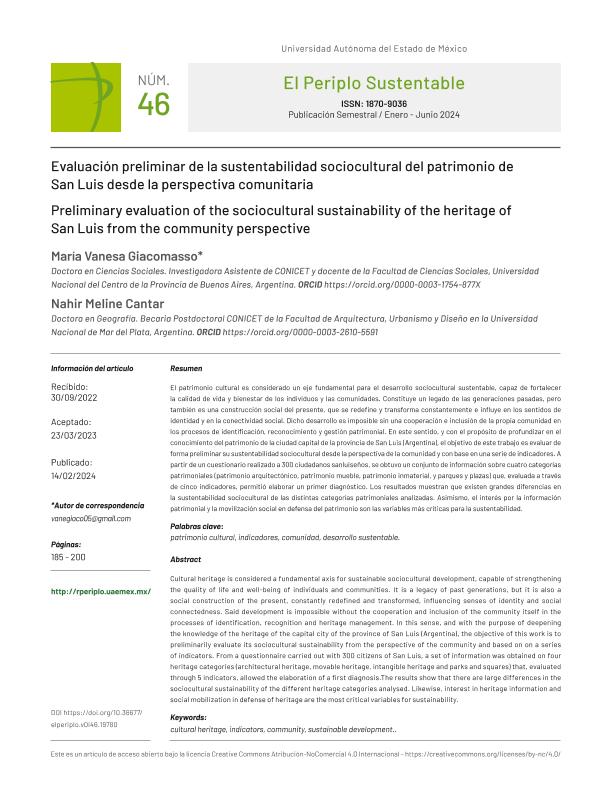Artículo
El patrimonio cultural es considerado un eje fundamental para el desarrollo sociocultural sustentable, capaz de fortalecer la calidad de vida y bienestar de los individuos y las comunidades. Constituye un legado de las generaciones pasadas, pero también es una construcción social del presente, que se redefine y transforma constantemente e influye en los sentidos de identidad y en la conectividad social. Dicho desarrollo es imposible sin una cooperación e inclusión de la propia comunidad en los procesos de identificación, reconocimiento y gestión patrimonial. En este sentido, y con el propósito de profundizar en el conocimiento del patrimonio de la ciudad capital de la provincia de San Luis (Argentina), el objetivo de este trabajo es evaluar de forma preliminar su sustentabilidad sociocultural desde la perspectiva de la comunidad y con base en una serie de indicadores. A partir de un cuestionario realizado a 300 ciudadanos sanluiseños, se obtuvo un conjunto de información sobre cuatro categorías patrimoniales (patrimonio arquitectónico, patrimonio mueble, patrimonio inmaterial, y parques y plazas) que, evaluada a través de cinco indicadores, permitió elaborar un primer diagnóstico. Los resultados muestran que existen grandes diferencias en la sustentabilidad sociocultural de las distintas categorías patrimoniales analizadas. Asimismo, el interés por la información patrimonial y la movilización social en defensa del patrimonio son las variables más críticas para la sustentabilidad. Cultural heritage is considered a fundamental axis for sustainable sociocultural development, capable of strengthening the quality of life and well-being of individuals and communities. It is a legacy of past generations, but it is also a social construction of the present, constantly redefined and transformed, influencing senses of identity and social connectedness. Said development is impossible without the cooperation and inclusion of the community itself in the processes of identification, recognition and heritage management. In this sense, and with the purpose of deepening the knowledge of the heritage of the capital city of the province of San Luis (Argentina), the objective of this work is to preliminarily evaluate its sociocultural sustainability from the perspective of the community and based on on a series of indicators. From a questionnaire carried out with 300 citizens of San Luis, a set of information was obtained on four heritage categories (architectural heritage, movable heritage, intangible heritage and parks and squares) that, evaluated through 5 indicators, allowed the elaboration of a first diagnosis.The results show that there are large differences in the sociocultural sustainability of the different heritage categories analysed. Likewise, interest in heritage information and social mobilization in defense of heritage are the most critical variables for sustainability.
Evaluación preliminar de la sustentabilidad sociocultural del patrimonio de San Luis desde la perspectiva comunitaria
Título:
Preliminary evaluation of the sociocultural sustainability of the heritage of
San Luis from the community perspective
Fecha de publicación:
07/2023
Editorial:
Universidad Autónoma del Estado de México
Revista:
El Periplo Sustentable
ISSN:
1870-9036
Idioma:
Español
Tipo de recurso:
Artículo publicado
Clasificación temática:
Resumen
Palabras clave:
PATRIMONIO CULTURAL
,
INDICADORES
,
COMUNIDAD
,
SUSTENTABILIDAD
Archivos asociados
Licencia
Identificadores
Colecciones
Articulos(CCT - MAR DEL PLATA)
Articulos de CTRO.CIENTIFICO TECNOL.CONICET - MAR DEL PLATA
Articulos de CTRO.CIENTIFICO TECNOL.CONICET - MAR DEL PLATA
Articulos(INCUAPA)
Articulos de INVESTIGACIONES ARQUEOLOGICAS Y PALEONTOLOGICAS DEL CUATERNARIO PAMPEANO
Articulos de INVESTIGACIONES ARQUEOLOGICAS Y PALEONTOLOGICAS DEL CUATERNARIO PAMPEANO
Citación
Giacomasso, Maria Vanesa; Cantar, Nahir Meline; Evaluación preliminar de la sustentabilidad sociocultural del patrimonio de San Luis desde la perspectiva comunitaria; Universidad Autónoma del Estado de México; El Periplo Sustentable; 46; 7-2023; 185-200
Compartir




